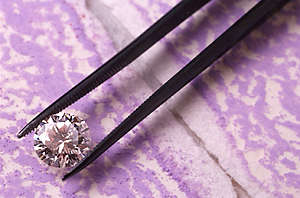
 |
|
 Using the four Cs is the way jewelers price their stones... ...and the way consumers should purchase a diamond, as well. It's the only way to determine the value of the gem. The more precise the cut of the diamond, the more brilliant it is (Cut) The less color in a diamond, the more beautiful it is (Color) The purer the diamond, the more valuable it is (Clarity) The larger the diamond, the rarer it is (Carat-Weight) Two diamonds that look alike at first may, in fact, be very different. Similarly, two diamonds of equal size can have very unequal values. To understand the differences is to understand the 4 Cs. Cut - Not just the shape, but the sparkle. Diamonds can be cut into a number of shapes, depending on the nature of the rough stone. The most popular shapes are: • Round brilliant-cut • Marquise • Emerald-cut • Pear-shaped • Oval • Heart-shaped • Princess • Radiant More than 75% of all diamonds sold are round stones. For many people, the solitaire, a single round diamond set in platinum or gold, is the ideal American engagement ring. But other shapes are also considered classics. Diamond jewelry can also be set with baguettes, trillions, or pear-shape side stones. Choice is a matter of personal taste. A well-cut diamond is the work of a master diamond cutter, since the cut enables the diamond to reflect light and create brilliance. A well-proportioned diamond reflects light from one facet to another and disperses it through the top of the stone as rainbows of color. Of all variables affecting diamond value, the cut is the most crucial. Mother Nature may determine a diamond's color, clarity, and carat-weight, but the hand of a master craftsman is needed to release its fire and beauty. The right cut gives each diamond unique sparkle and brilliance by allowing the maximum amount of light to enter and reflect back out of the diamond. If the cut is too deep or shallow, light will spill through the side or bottom and be lost, resulting in a less brilliant display and a less valuable diamond. A well-cut diamond is considerably more beautiful and valuable than a poorly cut stone of the same size, clarity, and color. Color - The best color is no color. Color is judged according to a grading scale. Diamond color grades start at D and continue through the alphabet all the way to Z. Colorless diamonds are the most valued because they are the most rare. Differences between one color grade and another are very subtle, particularly to the untrained eye. Although increasing shades of yellow reduce the value of a diamond, they do not necessarily reduce its beauty. If a diamond is well cut, its refraction and dispersion of light will often disguise certain degrees of coloration. Clarity - It's a rarity. The clarity of a diamond is determined by the presence or absence of tiny natural birthmarks known as "inclusions." In all diamonds, except the most rare, tiny traces of minerals, gasses, or other elements were trapped inside during the crystallization process. These are inclusions. They may look like tiny crystals, clouds, or feathers. They're what make each diamond different and unique. Most inclusions are not visible to the naked eye, but only under a jeweler's loupe. The fewer and smaller the inclusions, the higher the price. Inclusions usually don't affect a diamond's beauty, but their presence reduces the price of the diamond. Clarity is graded on a scale: • Internally flawless (IF) • Very, very small inclusions (VVS1-VVS2) • Very small inclusions (VS1-VS2) • Small inclusions (SI1-SI2-SI3) • Imperfect (I1-I2-I3) with inclusions that can be seen with the naked eye Carat-Weight - Bigger is not necessarily better. This is the easiest of the 4 Cs to determine. A diamond is measured in carats. One carat is divided into 100 "points," so that a diamond of 75 points, for example, weighs .75 carats. Fine quality can be found in diamonds of all carat weights. |
|
Store Hours: M-F 9 a.m. - 9 p.m. Sat. 9 a.m. - 5 p.m. Closed Sunday |